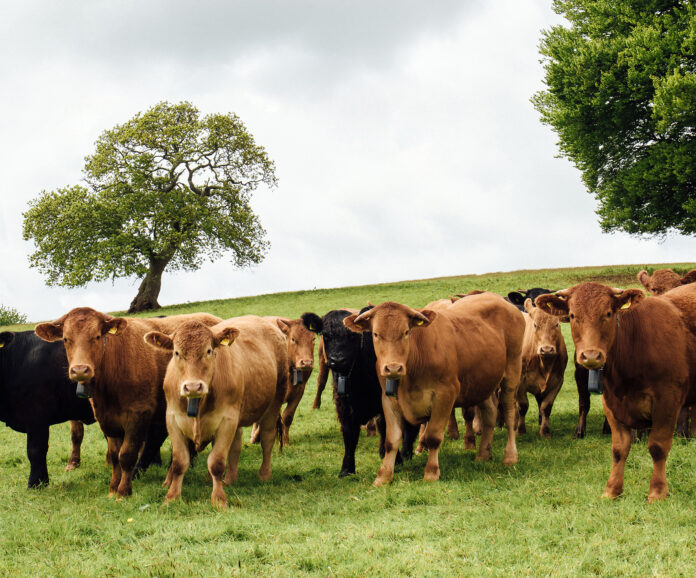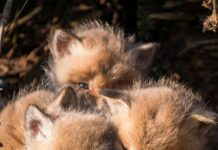The vital role of cattle in conservation is being highlighted in an ambitious project to transform a landscape and boost local ecology in south west Scotland.
Furthermore, there is early evidence that significant environmental gains are happening alongside effective herd management, showing that it is possible for these often-conflicting objectives to be achieved alongside one another.
One key element is the use of virtual fencing technology that has enabled the creation of an open and interconnected landscape, with self-contained public access, whilst allowing a herd of suckler cows and calves to both thrive and simultaneously drive the land regeneration.
The project is taking place within the National Trust for Scotland’s Threave Estate, near Castle Douglas in Dumfries and Galloway, and is part-funded by the Galloway Glens Land Partnership. It is focused on an area of 85ha designated as a nature reserve but – until relatively recently – has been largely under the influence of conventional tenanted dairy farming. Threave Estate head ranger David Thompson explains the background.
“Many years of intensive grazing and silage making by a series of tenants, with all the associated inputs, had left the 55ha of grassland within the nature reserve quite depleted,” he says. “With land restoration as the main priority, agreement was reached to set about creating a continuous natural landscape, with the indigenous grassland, woodland and wetlands all interconnected. This has involved the removal of all the old fencing that existed for 31 separate paddocks. It has also required the re-introduction of livestock, but in a way that is complementary to the regeneration objectives and – equally importantly – compatible with public access.
“We describe this approach as holistic planned grazing, whereby mainly cattle, but also some sheep, are given access to specified areas at designated times, thereby creating the optimum conditions for land regeneration and the most conducive environment for wildlife.
“This has only been possible using the Nofence virtual fencing system. In just four years since the project started, we are already seeing a transformation in the landscape, with all parties – including the landowner, the graziers and the public – benefitting from the progress.”
The Nofence system, developed in Norway, works from a mobile phone app that uses GPS to set a virtual boundary for the livestock. The animals wear collars that allow the app to track their live location, with a series of audio warnings used to alert them if they are too close to the boundary, with the warnings increasing in pitch if the animal continues forward. Training cattle to use their hearing rather than eyes for fencing boundaries has proven to be very effective on the Threave Estate, with very few escapes happening and very few pulses administered. If an animal does escape, the app sends a notification to the user with the live location.
The project is being overseen by the environmental consultancy Connicks, who began in 2019 by carrying out a basic survey of the area to assess what was there and – more importantly – the potential. Huw Connick, leading the project, recognised the importance of cattle in this context, but also understood the need to marry the needs of the tenant farmer, the ecology and the visiting public.
“Cattle are the flagship species for this project, and, we have an agreement with our grazing partners, Colin and Nicola Davidson, to manage their herd of pedigree Belted Galloways on the land,” he explains. “For most of the year, the cattle are moved around the open grassland area, having access to designated areas for periods of about seven days at a time. The grazing strategy is holistic, so takes account of all the ecological factors important for regeneration and – using technology like grazing heat maps – also ensures the cattle always have what they require. The cattle are only fenced in when they are running with the bull and when calving, for the safety of the visiting public.”
Apart from protecting Sites of Specific Scientific Interest (SSSI), holistic planned grazing using virtual fencing is facilitating natural regeneration, with remarkable results.
“Without sowing a single seed, we’re seeing the emergence of species like yellow rattle, cuckoo flower and scabious in the more marginal areas, and even oak saplings in areas of open grassland,” says Huw. “The herbage is typically knee-length for grazing, and the more diverse flora means deeper and more varied rooting, so soils are healthier, and the wildlife is thriving. Flocks of swallows and swifts flying above are indicative of the insect life below, so we are already creating a rich and diverse ecosystem.
“The Belted Galloway cattle are integral to the success, with their ability to do well on the mixed and varied swards, and controlling their movements without physical fencing means we have restored a totally natural landscape.”
Help keep news FREE for our readers
Supporting your local community newspaper/online news outlet is crucial now more than ever. If you believe in independent journalism, then consider making a valuable contribution by making a one-time or monthly donation. We operate in rural areas where providing unbiased news can be challenging. Read More About Supporting The West Wales Chronicle























